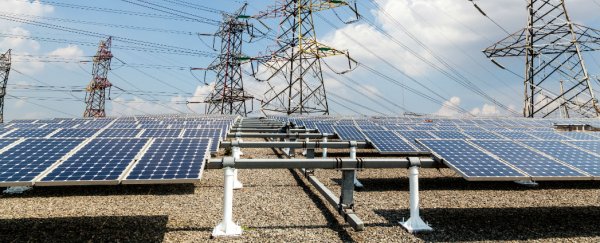The world's largest solar power station will be built in the central Indian state of Madhya Pradesh over the next 18 months, government officials announced over the weekend. The 750-megawatt (MW) facility will be built on barren government-owned land in the country's Rewa district, and when complete will positively dwarf the current world's largest solar power project - the 392-MW Ivanpah Solar Power Facility in the Mojave desert of California.
"Global tenders for commissioning the solar power station in an area over 1,500 hectares (15 km²) at Bandwar region in Gudh tehsil of Rewa, will be invited shortly," Madhya Pradesh's Energy Minister Rajendra Shukla told the press. He said they planned to have the plant up and running by March 2017.
Just last week, the Indian state of Cochin announced that it's in the process of transitioning its international airport to 100 solar power. As of May 2016, the airport will run on 46,150 solar panels, which are expected to produce enough power to run 10,000 homes each year and save 300,000 tonnes of carbon emissions over the next 25 years.
The two projects feed into a larger initiative that will see the country working towards the goal of generating 175,000 megawatts of renewable energy per year by 2022.
With an average of 300 clear, sunny days per year, India's solar power potential is about 5,000 trillion kilowatt-hours (kWh) per year, so the only thing holding them back right now is the infrastructure. And that figure only takes into account the available land space - if they decide to pursue floating solar power plants like the ones used by Japan, they'll have even greater potential for energy generation.
Not only is India determined to support itself using its own sunlight, it's also just announced that it will be sharing the spoils of its sunbaked land with Pacific island nations that are struggling to afford their own solar power facilities.
Over the weekend, leaders and delegates of 14 Pacific nations met in northern Indian state Rajasthan for a summit, at which the Indian Prime Minister Narendra Modi pledged to give its island neighbours enough solar power to light up thousands of homes.
"We now commit… to provide solar electrification to 2,800 houses - 200 houses in each Pacific island country. This will save kerosene worth about $1 million," Modi said.
The plan is to help these smaller nations deal with the effects of climate change in the coming decades, which experts predict will bring with it a higher frequency of natural disasters such as severe flooding and tsunamis. Along with dedicating a portion of the solar energy generated on Indian soil, the Prime Minster said India would also work with researchers in the Pacific nations to provide better human resources and technologies to deal with natural disaster management with early warning and response systems, the AFP reports.
"Low-lying island nations, some of which are little more than one metre above sea level, are regarded as some of the most vulnerable to rising seas," says the AFP. "The Pacific islands urged global cooperation during the conference, saying global warming has raised sea levels and eroded their coastlines and increased the severity of extreme climate phenomena, such as super typhoons."
Further plans regarding the fate of these Pacific nations will be discussed during the 2015 United Nations Climate Change Conference in Paris later this year, where world leaders will come together to formulate a legally binding and universal agreement on the future of Earth's climate. Watch this space.
